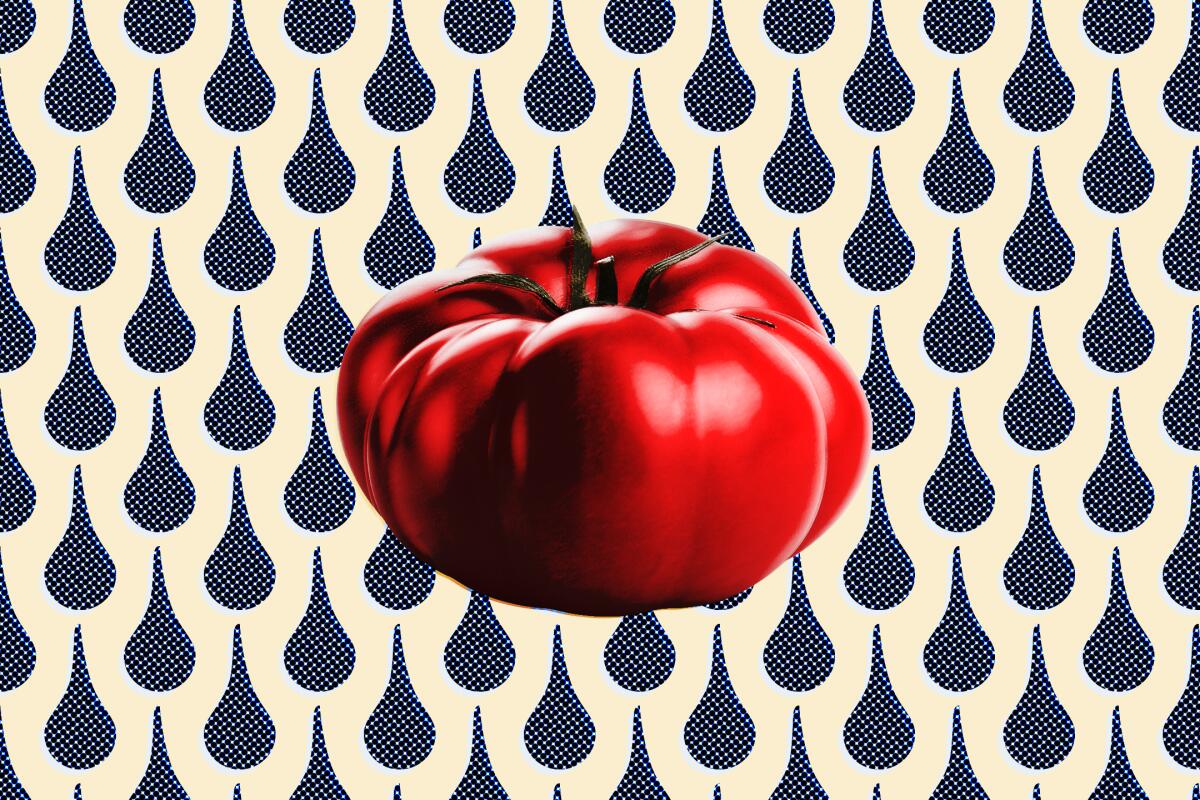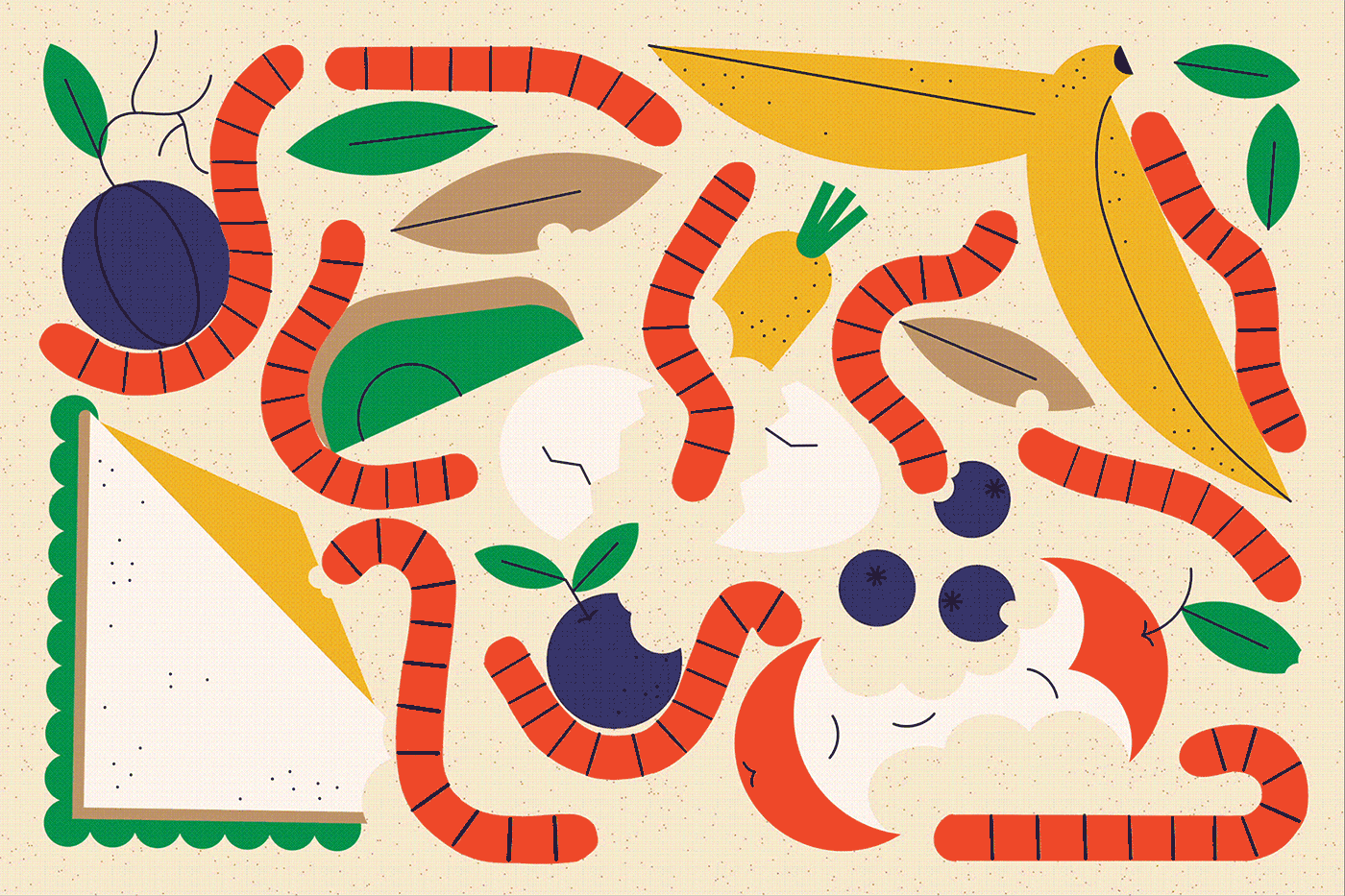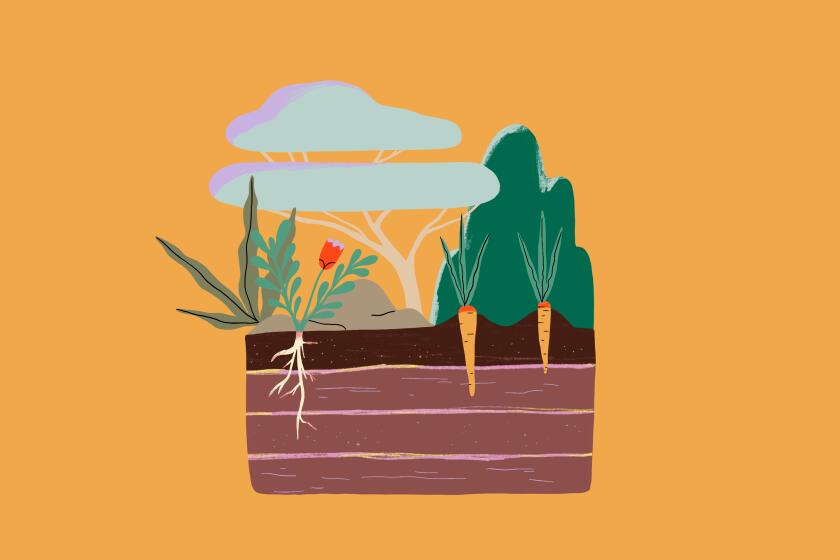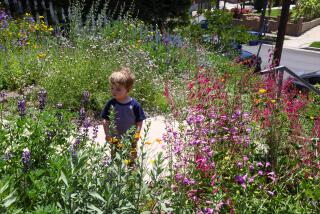We’re in a megadrought. Here’s how to keep your veggie garden alive this summer

- Share via
Many of us got hooked on growing vegetables during the pandemic. Digging in the dirt made us feel better and helped feed our families no matter how intense life got outside our bubble.
But we’re in a megadrought now and we’re experiencing the worst dry spell in 12 centuries due to climate change. Is it defensible, or even possible to keep a vegetable garden growing this summer, especially when the Metropolitan Water District, one of Southern California’s largest water providers, is limiting outdoor watering to just one day a week starting June 1?
Yes and yes, gardening experts say, because growing veggies feeds our bodies and our souls. But we’re going to have to change our ways and give our beloved gardens some tough love by training our plants now to send their roots deep into the ground, says Yvonne Savio, retired long-time coordinator of the Los Angeles County Cooperative Extension Master Gardener program and creator of the GardeninginLA.net website.
“In most cases, people are watering too much anyway, so one day a week is very doable and will probably be better for everybody, including the plants,” Savio says. “My neighbor used to come home and sprinkle her garden every night. She did it for her benefit because it was relaxing, but her plants had roots that were barely an inch into the soil. Her watering satisfied them each night, but when the 100-degree heat came all her plants were dead because there had been no system for their roots to grow deeper. Consequently, they literally fried in the soil.”
Drought-resistant plants like hummingbird sage and rosemary are the ideal addition to Southern California gardens.
With the right techniques, such as infrequent deep watering, and equipment, such as drip irrigation, we can still grow food and drought-resistant plants, especially those native to Southern California. By training your plants now, they can adjust to this new feeding style before water restrictions come into play, and the heat of summer is upon us.
Even if you don’t live in the Metropolitan Water District, basic decency requires Californians to reduce their water consumption however they can.
“Obviously eating is a necessity, but whether they’re a necessity or just nice to have, vegetable gardens are fundamental to the quality of our lives,” said Dan Allen, CEO of Farmscape, an L.A. firm that helps design, install and manage vegetable gardens, urban farms, native plants and dry-summer gardens. “We all want a city that’s lush and livable, but we have to use less water going forward, so we need the right plants and materials to make that possible.”
In other words, lawns and water-thirsty ornamentals are expendable, along with inefficient sprinkler systems that throw water in the air, gardening advocates say.
How do you save water in your veggie garden? Send your photos and tips to [email protected]
You should also be hand watering your trees, even if it means filling a big, plastic tub in your shower and then carrying it outside.We’re going to need as much cooling shade as we can find in Southern California, especially if our lawns go brown.
That said, here are some tips from expert gardeners on how to handle your trees and vegetable gardens during the megadrought and the many heat waves expected to come.
1. Don’t frequently water your mature trees
Established trees actually prefer infrequent deep watering a couple times a month, says Krista Guerrero, a member of the Metropolitan Water District’s water efficiency team.
If you have trees growing in a lawn, Guerrero recommends:
- Removing the grass around the tree about 4 feet in every direction to create a basin for deep watering
- Turning the hose on low and letting it run for about 20 minutes once or twice a month
- If the water starts overflowing the reservoir, moving the hose somewhere else and letting the water sink into the ground before adding more
You can water like that weekly during the hottest parts of summer, she says, but the trees don’t need more than one good deep drink a week.

Subscribers get exclusive access to this story
We’re offering L.A. Times subscribers special access to our best journalism. Thank you for your support.
Explore more Subscriber Exclusive content.
Other tips from garden experts include:
- Adding a few inches of fine-screened bark mulch around your trees, such as Xerimulch (in bags) or bulk fine or super-fine wood mulches, such as those sold by Cal Blend Soils in Irwindale. A fine bark mulch breaks down quicker, mimicking a forest floor, while retaining moisture.
- Keeping the mulch 4 inches away from the trunk of the trees to avoid rotting and suffocating the roots.
- Staying away from rubber or dyed mulches. They don’t retain moisture or cool the soil, and they can leach chemicals into the ground.
2. Plant veggies now so they adjust to less water
To stay alive this summer, your vegetable plants must be trained to send their roots deep into the ground to find water and cooling shade, Savio says. Frequent shallow watering just encourages the roots to stay near the surface, which will spell disaster when the weather gets hot. It also means the plants are less efficient at pulling nutrients from the soil.
That means SoCal gardeners should, if they haven’t already, get their veggies in the soil ASAP, because seedlings need time to settle in to their new surroundings, says Geri Miller, owner of Home Grown Edible Landscapes and the Cook’s Garden in Venice.
Allen agrees. “The more established your plants are, the deeper your roots will be,” he says. “If you wait until June to plant your veggies, you’re better off waiting until the fall.”
Worm composting, or vermicomposting, turns food waste into worm castings that are great for garden soil. Here’s how to start worm composting at home.
3. Invest in good organic soil, full of organic amendments
This may seem like a small thing, but “people who build good-quality soil will be rewarded,” says Allen, because good soil drains well but also holds on to moisture and nutrients, so your plants are nourished and protected from excessive heat.
Organic amendments are “kind of magic for both clay soil and sandy soil,” says Savio, “because they provide the extra sponginess for sandy soil to hold the water, but it also drains clay soils by adding more air spaces” so you don’t have plants getting rotted roots from standing in water.
Savio recommends amendments such as:
- compost
- steer manure
- rabbit manure
Chicken manure can also be a good amendment, but use it sparingly because it has much more nitrogen than the other manures and can raise the soil temperature high enough to kill or damage your plants.
“You can stretch a bag further,” Savio says, “but the few times I’ve used it, I found that chicken manure just burns the hell out of everything anyway, even using a lesser amount.”
4. You can water more often and efficiently with drip irrigation
Drip irrigation systems are exempt from the one-day-a-week watering rules because they use so little water, says Guerrero.
“We count the output from [traditional] sprinklers in gallons per minute, versus gallons per hour with drip,” she says. “Drip irrigators use 50% to 70% less water. We like to say one sprinkler nozzle is the equivalent of taking a single shower, so if you have 30 sprinkler nozzles in your yard, it’s like taking 30 showers every time you water.”
Drip systems should be automated so you can water in the early morning hours, when there’s less evaporation. You can use special emitters to put the water on specific plants or lay a half-inch header hose across one end of your garden bed and attach quarter-inch soaker hoses spaced 6 inches apart. The soaker hoses leak water out of holes spaced every 6 inches along the line, so you get your soil uniformly wet, Allen says. Preferably, the drip irrigation system should be installed so you can tailor the water timing to your veggie plants’ needs.
However, the amount of water you need to thoroughly soak your garden bed will depend on your soil, water pressure and the maturity of your plants, Miller says.
Skeptics were plentiful when L.A. Arboretum expert Leigh Adams first used waste cardboard to rebuild lousy soil. But they believe it now.
You can’t tell how deep the water is going by looking at the soil surface, so she recommends investing in an inexpensive soil moisture meter to test how deep the water is going.
For instance, if you’ve just planted small seedlings, their roots aren’t going to be more than 3 or 4 inches deep into the ground. So for the first two weeks, Miller runs her drip system for two minutes a day, just so the plants can settle into their new home.
After they are established and show some growth, switch to watering every other day for five minutes, Allen says.
“It can be a real shock to your plants if you do a sudden adjustment on their drip irrigation,” he says. Instead, make the change over the next few weeks, reducing water times to just two or three times a week, and maybe increasing the amount of water per session by a minute or two. “All of this will push the roots deeper,” he says.
If the water starts running out of the bottom of your raised bed or pooling, cut the time back by a couple minutes. And until you get a routine, check the soil with your moisture meter every day to determine when it’s time to water again.
5. Bury 5-gallon nursery pots in your garden to send water deep down
Savio has a lush vegetable garden behind her Pasadena home, and her watering relies almost entirely on 5-gallon nursery pots — the sturdy black plastic pots with holes in the bottom that nurseries use to hold their plants.
She buries the pots in her garden so the tops are just 3 or 4 inches above the soil to prevent skittering lizards from falling inside. She plants around the pots and then once a week — maybe twice a week in the hottest days of summer — she fills the pots with water and lets all that moisture sink into the ground before filling them again.
Fertilizing is easy too — she just adds a shovel full of manure to the pot, adds water and voila, creates manure tea. You can also add liquid fertilizers to the water, but be sure to follow the quantity instructions on the bottle.
This technique works well when you plant vegetables close together rather than in traditional rows, which is known as intensive gardening, Savio says. Professional gardeners often plant intensively and cool the soil with overlapping leaves to increase yields.
“I currently have artichokes next to a Sungold tomato and next to that is a sage plant and then some cilantro, but my watering the tomato takes care of everything else. The other plants are side beneficiaries, so to speak,” Savio says.
It’s a good idea to group plants according to their root depth, she adds. Artichokes, asparagus, melons, pumpkins and tomatoes have the deepest root systems — up to 3 feet, whereas peppers, eggplants and beans only go about 2 feet down.
You can use 1-gallon nursery pots to water around shallow-rooted crops like celery, beets, lettuce, onions, radishes and potatoes, she says. Her father-in-law buried 1-gallon nursery pots in his garden, but he had to fill them up too many times, she says, so she decided it was more effective to use 5-gallon pots.
Finding your favorite nursery can be thrilling. Here are our picks for the best independently owned plant nurseries near Los Angeles.
The pots used to be readily available at most nurseries, who would either give them away or sell them for a small amount. They’re harder to find today, but call around. Many nurseries still keep piles of used pots in their potting area, and they may be willing to sell them.
6. Big PVC pipes send water deep into the ground too
Cypress resident Dave Freed, who’s known as the Tomato Guy, sends water deep into the ground with perforated PVC pipes.
He drills holes in 4-inch PVC pipes and then buries them 18 to 20 inches, with the top sticking out above the soil so you can pour water in the pipe with a hose. He has instructions for how to make these watering pipes and also sells pre-prepared pipes for $8. Learn more on his website “Grow Tomatoes Easily.”
During the megadrought, you’ll just have to pay closer attention to your garden — and learn new tending techniques, which in the long run will be better for your plants even if you weren’t forced to restrict water use.
More to Read
Sign up for This Evening's Big Stories
Catch up on the day with the 7 biggest L.A. Times stories in your inbox every weekday evening.
You may occasionally receive promotional content from the Los Angeles Times.















